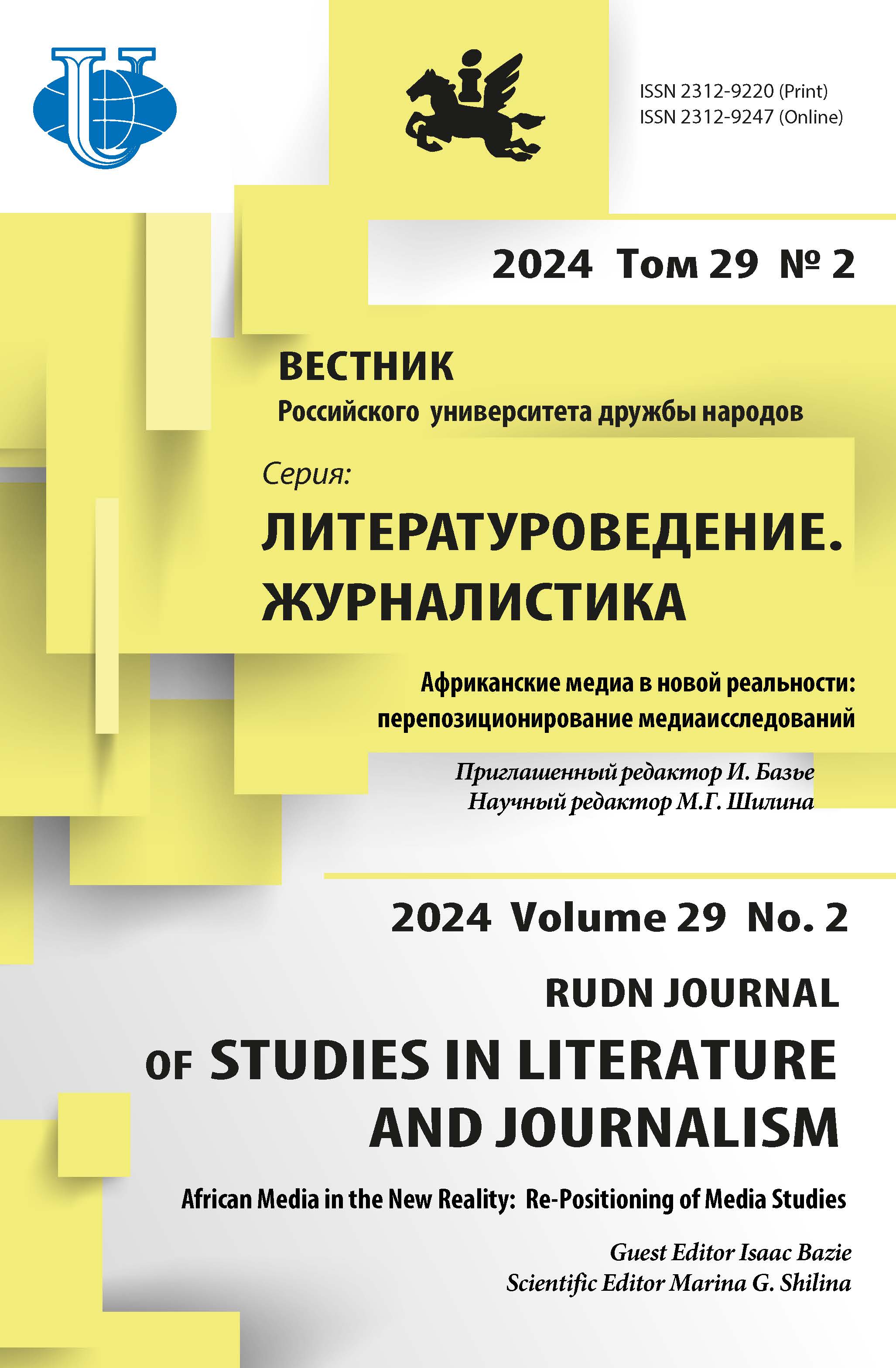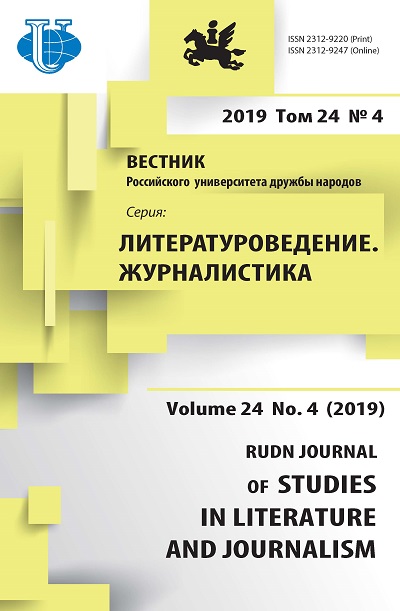Три лика Трикстера в современной политике: Дональд Трамп, Алексей Навальный и Джулиан Ассанж
- Авторы: Черненко Ю.А.1
-
Учреждения:
- Национальный исследовательский университет «Высшая школа экономики»
- Выпуск: Том 24, № 4 (2019)
- Страницы: 756-764
- Раздел: Журналистика
- URL: https://journals.rudn.ru/literary-criticism/article/view/23075
- DOI: https://doi.org/10.22363/2312-9220-2019-24-4-756-764
Цитировать
Полный текст
Аннотация
Актуальность представленной статьи обусловлена многократно возросшим в условиях политики постправды интересом акторов политической коммуникации к архетипическому образу Трикстера. Автор статьи последовательно показывает преимущества и возможности политиков-Трикстеров в условиях цифровой культуры и информационного общества, когда происходит повсеместная медиатизация политики. Цель исследования - проанализировать разные варианты использования образа Трикстера в политической коммуникации в России и мире на примерах трех часто встречающихся в новостной повестке 2010-2018 гг. политических фигур: Дональда Трампа, Алексея Навального и Джулиана Ассанжа. В исследовании автор использует материалы социальных медиа, в которых ведут политическую коммуникацию указанные акторы, журналистский контент и материалы СМИ, интервью для изданий. Автор статьи приходит к выводу, что Трикстер в современной медиасреде обладает куда большим коммуникационным потенциалом, чем более традиционные архетипы Героя и Мудрого Правителя. Подчеркивается, что неоднозначность трактовки образа Трикстера, хотя и осложняет применение этого образа политическими акторами, может стать одним из факторов, благодаря которым деятель добивается успеха в политической борьбе. На материалах политической коммуникации продемонстрированы три варианта обращения к образу Трикстера: классический Трикстер (Шут, Дурак), Трикстер как Герой (Робин Гуд) и Трикстер как Шаман (Крысолов и Мессия).
Ключевые слова
Об авторах
Юлия Александровна Черненко
Национальный исследовательский университет «Высшая школа экономики»
Автор, ответственный за переписку.
Email: juchernenko@hse.ru
кандидат филологических наук, эксперт лаборатории образовательной и молодежной журналистики, преподаватель департамента медиа, факультет коммуникаций, медиа и дизайна
Российская Федерация, 101000, Москва, ул. Мясницкая, 20Список литературы
- Wimmer J. et al. (Mis)Understanding Political Participation: Digital Practices, New Forms of Participation and the Reneval. New York: Taylor and Francis, 2018.
- Шомова С.А. От мистерии до стрит-арта: очерки об архетипах культуры в политической коммуникации. М.: Высшая школа экономики, 2016.
- Mayer F.W. Narrative Politics: Stories and Collective Action. New York: Oxford University Press, 2014.
- Черненко Ю.А. Political Storytelling in Digital Culture: A Tool for Post-Truth Politics? // Коммуникации. Медиа. Дизайн. 2017. Т. 2. № 1. URL: https://cmd-journal.hse.ru/ article/view/6837 (дата обращения: 01.06.2019).
- Vogler C. The Writer’s Journey: Mythic Structures for Writers. Studio City: Michael Wiese Productions, 2007.
- Чернявская Ю.В. Трикстер, или Путешествие в Хаос // Человек. 2004. № 3. С. 37–52.
- Шкурко Н.С. Использование архетипов Героя и Трикстера в создании образов политических деятелей // Молодий вчений. 2014, апрель. № 4 (07). C. 12–15.
- Lee J.C., Quealy K. The 598 People, Places and Things Donald Trump Has Insulted on Twitter: A Complete List // New York Times. 2019, 24 мая. URL: https://www.nytimes. com/interactive/2016/01/28/upshot/donald-trump-twitter-insults.html?ref=politics&_ r=2 (accessed: 04.06.2019).
- Offi cial Twitter of Donald Trump. URL: https://twitter.com/realdonaldtrump (accessed: 04.06.2019).
- Siddiqui S. Donald Trump calls Barack Obama the Founder of ISIS // The Guardian. 2016, 11 August. URL: https://www.theguardian.com/us-news/2016/aug/11/donaldtrump-calls-barack-obama-the-founder-of-isis (accessed: 04.06.2019).
- Soloviev V., Klepikova E. Donald Trump. Fight for the White House. Moscow: RIPOL Classic, 2016.
- Offi cial Twitter of Hillary Clinton. URL: https://twitter.com/hillaryclinton (accessed: 04.06.2019).
- The Economist. 2018, 11 January. URL: https://www.economist.com/ printedition/ 2018-01-13 (accessed: 04.06.2019).
- Blake A. The First Trump Clinton Presidential Debate Transcript Annotated // The Washington Post. 2016, 27 September. URL: https://www.washingtonpost.com/ news/the-fix/wp/2016/09/26/the-first-trump-clinton-presidential-debate-transcriptannotated/ (accessed: 04.06.2019).
- Auslander S. Don’t compare Donald Trump to Adolf Hitler. It belittles Hitler // The Washington Post. 2016, 13 September. URL: https://www.washingtonpost.com/ posteverything/wp/2016/09/13/dont-compare-donald-trump-to-adolf-hitler-it-belittleshitler/?utm_term=.4ff 82af31de5 (accessed: 04.06.2019).
- Ball J., Rusbridger A., Brooke H. et al. Who is Julian Assange? By the people who know him best. URL: https://www.theguardian.com/ media/2012/aug/24/who-is-julianassange (accessed: 04.06.2019).
- Booker C. The seven basic plots: why we tell stories. New York: Continuum, 2004.
- Lucaites J.L., Condit C.M. Re-constructing Narrative Theory: A Functional Perspective // Journal of Communication. 1985. Vol. 35. No. 4. Pp. 90–108.
- Thompson R., Haddock G. Sometimes stories sell: when are narrative appeals most likely to work? // European Journal of Social Psychology. 2012. Vol. 42. No. 1. Pp. 92–102.
















